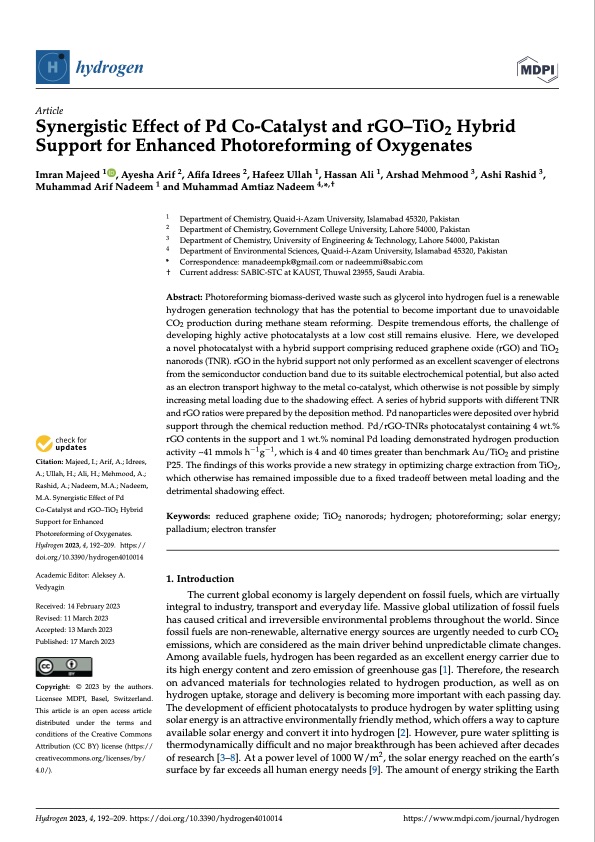
PDF Publication Title:
Text from PDF Page: 001
Article Synergistic Effect of Pd Co-Catalyst and rGO–TiO2 Hybrid Support for Enhanced Photoreforming of Oxygenates Imran Majeed 1 , Ayesha Arif 2, Afifa Idrees 2, Hafeez Ullah 1, Hassan Ali 1, Arshad Mehmood 3, Ashi Rashid 3, Muhammad Arif Nadeem 1 and Muhammad Amtiaz Nadeem 4,*,† 1 2 3 4 * Correspondence: manadeempk@gmail.com or nadeemmi@sabic.com † Current address: SABIC-STC at KAUST, Thuwal 23955, Saudi Arabia. Abstract: Photoreforming biomass-derived waste such as glycerol into hydrogen fuel is a renewable hydrogen generation technology that has the potential to become important due to unavoidable CO2 production during methane steam reforming. Despite tremendous efforts, the challenge of developing highly active photocatalysts at a low cost still remains elusive. Here, we developed a novel photocatalyst with a hybrid support comprising reduced graphene oxide (rGO) and TiO2 nanorods (TNR). rGO in the hybrid support not only performed as an excellent scavenger of electrons from the semiconductor conduction band due to its suitable electrochemical potential, but also acted as an electron transport highway to the metal co-catalyst, which otherwise is not possible by simply increasing metal loading due to the shadowing effect. A series of hybrid supports with different TNR and rGO ratios were prepared by the deposition method. Pd nanoparticles were deposited over hybrid support through the chemical reduction method. Pd/rGO-TNRs photocatalyst containing 4 wt.% rGO contents in the support and 1 wt.% nominal Pd loading demonstrated hydrogen production activity ~41 mmols h−1g−1, which is 4 and 40 times greater than benchmark Au/TiO2 and pristine P25. The findings of this works provide a new strategy in optimizing charge extraction from TiO2, which otherwise has remained impossible due to a fixed tradeoff between metal loading and the detrimental shadowing effect. Keywords: reduced graphene oxide; TiO2 nanorods; hydrogen; photoreforming; solar energy; palladium; electron transfer 1. Introduction The current global economy is largely dependent on fossil fuels, which are virtually integral to industry, transport and everyday life. Massive global utilization of fossil fuels has caused critical and irreversible environmental problems throughout the world. Since fossil fuels are non-renewable, alternative energy sources are urgently needed to curb CO2 emissions, which are considered as the main driver behind unpredictable climate changes. Among available fuels, hydrogen has been regarded as an excellent energy carrier due to its high energy content and zero emission of greenhouse gas [1]. Therefore, the research on advanced materials for technologies related to hydrogen production, as well as on hydrogen uptake, storage and delivery is becoming more important with each passing day. The development of efficient photocatalysts to produce hydrogen by water splitting using solar energy is an attractive environmentally friendly method, which offers a way to capture available solar energy and convert it into hydrogen [2]. However, pure water splitting is thermodynamically difficult and no major breakthrough has been achieved after decades of research [3–8]. At a power level of 1000 W/m2, the solar energy reached on the earth’s surface by far exceeds all human energy needs [9]. The amount of energy striking the Earth Department of Chemistry, Quaid-i-Azam University, Islamabad 45320, Pakistan Department of Chemistry, Government College University, Lahore 54000, Pakistan Department of Chemistry, University of Engineering & Technology, Lahore 54000, Pakistan Department of Environmental Sciences, Quaid-i-Azam University, Islamabad 45320, Pakistan Citation: Majeed, I.; Arif, A.; Idrees, A.; Ullah, H.; Ali, H.; Mehmood, A.; Rashid, A.; Nadeem, M.A.; Nadeem, M.A. Synergistic Effect of Pd Co-Catalyst and rGO–TiO2 Hybrid Support for Enhanced Photoreforming of Oxygenates. Hydrogen2023,4,192–209. https:// doi.org/10.3390/hydrogen4010014 Academic Editor: Aleksey A. Vedyagin Received: 14 February 2023 Revised: 11 March 2023 Accepted: 13 March 2023 Published: 17 March 2023 Copyright: © 2023 by the authors. Licensee MDPI, Basel, Switzerland. This article is an open access article distributed under the terms and conditions of the Creative Commons Attribution (CC BY) license (https:// creativecommons.org/licenses/by/ 4.0/). Hydrogen 2023, 4, 192–209. https://doi.org/10.3390/hydrogen4010014 https://www.mdpi.com/journal/hydrogenPDF Image | Enhanced Photoreforming of Oxygenates

PDF Search Title:
Enhanced Photoreforming of OxygenatesOriginal File Name Searched:
hydrogen-04-00014-v2.pdfDIY PDF Search: Google It | Yahoo | Bing
Salgenx Redox Flow Battery Technology: Power up your energy storage game with Salgenx Salt Water Battery. With its advanced technology, the flow battery provides reliable, scalable, and sustainable energy storage for utility-scale projects. Upgrade to a Salgenx flow battery today and take control of your energy future.
| CONTACT TEL: 608-238-6001 Email: greg@infinityturbine.com | RSS | AMP |